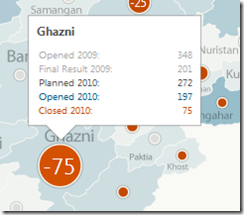Polling Centers: The Ones That Didn’t Open
Kabul, Oct 7 – Here’s a follow-up our previous analysis map which compares the 2009 Polling Centers the IEC says opened and the 2010 Polling Centers it planned to open. The map below updates the information with data on which polling centers actually opened: the shade of the province illustrates the number of polling centers opened (the scale is at the bottom right-hand corner) while the size of the circle reflects the numbers of polling centers which had been planned to open but remained closed. Gray circles indicate those provinces where all the planned centers opened.
Moving your mouse over each circle will prompt a box listing the data for each province, like this:
As can be seen, the province with by far the largest closed centers is Ghazni, with 75; followed some way behind by the northern provinces of Baghlan, Balkh and Juzjan (25, 22, and 22 respectively).
Ghazni has been flagged as a province with significant security challenges:
- Candidates warned before the election that “in many remote and insecure parts of Ghazni national and international election observers and monitors cannot go and do their work. Thus, it is making the possibility of holding a fair and transparent election even more difficult.” (Ghazni MP and candidate Shah Gul Razaie, quoted in 8 am, a Dari daily, on Sept 7, 2010.
- A month earlier, on August 6, the decapitated body of candidate Najibullah Gulistani was found in the province; he had been missing for 18 days before his body was found.
- A few days before the election Arif Rahmani, a candidate in Ghazni province, came under attack from armed men in a region close to his home town. One of his bodyguards was wounded.
Comparing this with the map of polling centers opened in 2009 with those planned for this year, it can be seen that plans for Ghazni were scaled back already this year, after results from more than 40% of the province’s polling centers were rejected. The number of polling centers actually opened this year, therefore, is quite similar to the number of polling centers whose results were included in last year’s final count.
A further interactive map will be created once the IEC and ECC complete a list of polling centers where results were nullified because of fraud.
(Graphic Credit: InteractiveThings)
Other infographics can be found here. For content concerning polling centers, go here.






